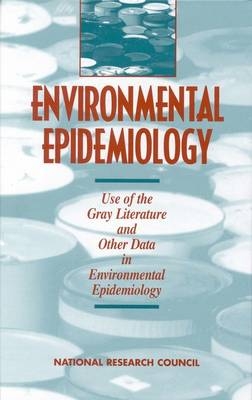
Environmental Epidemiology, Volume 2
Use of the Gray Literature and Other Data in Environmental Epidemiology
Seiten
1997
National Academies Press (Verlag)
978-0-309-05737-0 (ISBN)
National Academies Press (Verlag)
978-0-309-05737-0 (ISBN)
Determining the health risks to humans of exposure to toxic substances in the environment is made difficult by problems such as measuring the degree to which people have been exposed and determining causation. This volume describes effective epidemiological methods for analyzing data and focuses on errors that may occur in the course of analyses.
Determining the health risks to humans of exposure to toxic substances in the environment is made difficult by problems such as measuring the degree to which people have been exposed and determining causation—whether observed health effects are due to exposure to a suspected toxicant. Building on the well-received first volume, Environmental Epidemiology: Hazardous Wastes and Public Health, this second volume continues the examination of ways to address these difficulties. It describes effective epidemiological methods for analyzing data and focuses on errors that may occur in the course of analyses.
The book also investigates the utility of the gray literature in helping to identify the often elusive causative agent behind reported health effects. Although gray literature studies are often based on a study group that is quite small, use inadequate measures of exposure, and are not published, many of the reports from about 20 states that were examined by the committee were judged to be publishable with some additional work. The committee makes recommendations to improve the utility of the gray literature by enhancing quality and availability.
Table of Contents
Front Matter
1 Environmental Epidemiology: The Context
2 Environmental-Epidemiology Studies: Their Design and Conduct
3 Exposure Assessment in Environmental Epidemiology
4 Researching a Broad Range of Health Outcomes
5 Data Systems and Opportunities for Advances
6 Opportunities for Methodologic Advances in Data Analysis
7 Review of the Gray Literature from State Reports
8 Major Conclusions and Recommendations
Index
Determining the health risks to humans of exposure to toxic substances in the environment is made difficult by problems such as measuring the degree to which people have been exposed and determining causation—whether observed health effects are due to exposure to a suspected toxicant. Building on the well-received first volume, Environmental Epidemiology: Hazardous Wastes and Public Health, this second volume continues the examination of ways to address these difficulties. It describes effective epidemiological methods for analyzing data and focuses on errors that may occur in the course of analyses.
The book also investigates the utility of the gray literature in helping to identify the often elusive causative agent behind reported health effects. Although gray literature studies are often based on a study group that is quite small, use inadequate measures of exposure, and are not published, many of the reports from about 20 states that were examined by the committee were judged to be publishable with some additional work. The committee makes recommendations to improve the utility of the gray literature by enhancing quality and availability.
Table of Contents
Front Matter
1 Environmental Epidemiology: The Context
2 Environmental-Epidemiology Studies: Their Design and Conduct
3 Exposure Assessment in Environmental Epidemiology
4 Researching a Broad Range of Health Outcomes
5 Data Systems and Opportunities for Advances
6 Opportunities for Methodologic Advances in Data Analysis
7 Review of the Gray Literature from State Reports
8 Major Conclusions and Recommendations
Index
Committee on Environmental Epidemiology, National Research Council
1 Front Matter; 2 1 Environmental Epidemiology: The Context; 3 2 Environmental-Epidemiology Studies: Their Design and Conduct; 4 3 Exposure Assessment in Environmental Epidemiology; 5 4 Researching a Broad Range of Health Outcomes; 6 5 Data Systems and Opportunities for Advances; 7 6 Opportunities for Methodologic Advances in Data Analysis; 8 7 Review of the Gray Literature from State Reports; 9 8 Major Conclusions and Recommendations; 10 Index
| Erscheint lt. Verlag | 26.7.1997 |
|---|---|
| Verlagsort | Washington |
| Sprache | englisch |
| Maße | 152 x 229 mm |
| Themenwelt | Medizin / Pharmazie ► Medizinische Fachgebiete ► Arbeits- / Sozial- / Umweltmedizin |
| Studium ► Querschnittsbereiche ► Epidemiologie / Med. Biometrie | |
| Naturwissenschaften ► Biologie ► Ökologie / Naturschutz | |
| ISBN-10 | 0-309-05737-X / 030905737X |
| ISBN-13 | 978-0-309-05737-0 / 9780309057370 |
| Zustand | Neuware |
| Haben Sie eine Frage zum Produkt? |
Mehr entdecken
aus dem Bereich
aus dem Bereich
ein überfälliges Gespräch zu einer Pandemie, die nicht die letzte …
Buch | Hardcover (2024)
Ullstein Buchverlage
CHF 34,95


